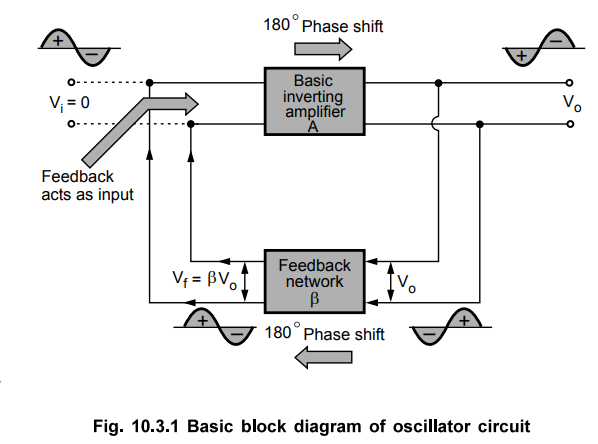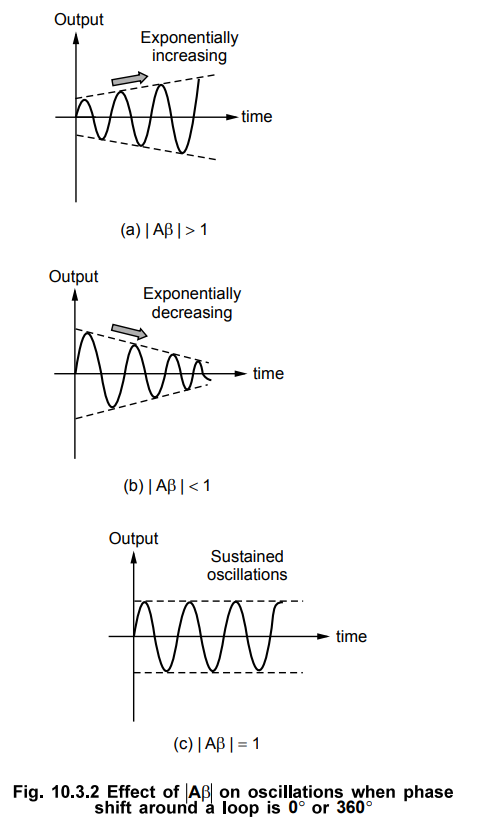Electron Devices and Circuits: Unit V: (b) Oscillators
Barkhausen Criterion for Oscillators
• For an oscillator, there is no input (Vs = 0) hence feedback voltage Vf must be sufficient to maintain the oscillations.
Barkhausen Criterion for Oscillators
•
For an oscillator, there is no input (Vs = 0) hence feedback voltage Vf must be
sufficient to maintain the oscillations.
•
To ensure this, oscillator must satisfy the criterion called Barkhausen
criterion.
•
Consider an inverting amplifier producing 180° phase shift between input and
output.
•
To ensure positive feedback, there must be further 180° phase shift between
output Vo and feedback voltage Vf. Thus the feedback voltage is in phase with
input ensuring positive feedback.
•
The arrangement is shown in the Fig. 10.3.1 where fictitious voltage Vi is
applied at the input of the amplifier.

•
Vo = A Vi while Vf = - β Vo where negative indicates 180° phase shift between Vo and Vf.
Vf
= -A β Vi
•
For oscillator, Vi = 0 and Vf must drive the circuit
hence Vf = Vi

•
The condition -A β = 1 is called Barkhausen condition.
•
From equation (10.3.1) we can write, A β = -1 + j0 hence equating magnitudes,
|
A β | = 1 ... (10.3.2)
•
And to have phase of Vf same as phase of Vf i.e. positive feedback, total phase
shift around a loop must be 180° by forward path +180° by feedback path i.e.
360°.
•
The two conditions discussed above, required to work the circuit as an
oscillator are called Barkhausen criterion for oscillation.
The
Barkhausen criterion states that :
1.
The total phase shift around a loop, as the signal proceeds from input through
amplifier, feedback network back to input again, completing a loop, is
precisely 0° or 360°, or of course an integral multiple of 2π radians.
2.
The magnitude of the product of the open loop gain of the amplifier (A) and the
feedback factor β is unity i.e. | A β | =1.
•
Satisfying these conditions, the circuit works as an oscillator producing
sustained oscillations with constant frequency and amplitude.
•
In reality no input is required. To overcome energy loss initially | A β | is
adjusted slightly greater than 1 and then circuit adjusts itself to get | A β |
= 1, to produce oscillations.
1. Effect of |Aβ | on Oscillations
•
When total phase shift around a loop is 0° or 360° and |A β | > 1 then the
output oscillations are of increasing amplitude as shown in the Fig. 10.3.2
(a), making system unstable.
•
When total phase shift around a loop is 0° or 360° and |A β | < 1 then
oscillations are damped with decreasing amplitude as shown in the Fig. 10.3.2
(b).
 • When total phase shift around a loop is 0°
or 360° and | A β | = 1 i.e. Barkhausen conditions are satisfied then circuit
works as an oscillator producing sustained oscillations as shown in the Fig.
10.3.2 (c).
• When total phase shift around a loop is 0°
or 360° and | A β | = 1 i.e. Barkhausen conditions are satisfied then circuit
works as an oscillator producing sustained oscillations as shown in the Fig.
10.3.2 (c).
2. Frequency of Oscillations
•
The frequency at which circuit satisfies both the Barkhausen conditions i.e.| A
β | = 1 and ∠A
β = 0° or 360° simultaneously is called frequency of oscillations.
3. Starting Voltage
•
For oscillators, external input is zero then how oscillators produce output ?
•
Every electronic component such as resistance has free electrons which move
randomly inside the component.
•
Such a random movement of free electrons in various directions produces a
voltage called noise voltage.
•
Such a noise voltage is amplified by the amplifier and fed back at the input.
•
As this voltage is small, initially | A β | is slightly greater
than one so that amplified noise voltage appears at the output.
•
The part of this voltage is sufficient to drive the circuit and then circuit
adjusts itself to get |A β| = 1 and starts working as an
oscillator without any external input.
Review Question
1. Explain the Barkhausen criterion in detail.
Electron Devices and Circuits: Unit V: (b) Oscillators : Tag: : - Barkhausen Criterion for Oscillators
Related Topics
Related Subjects
Electron Devices and Circuits
EC3301 3rd Semester EEE Dept | 2021 Regulation | 3rd Semester EEE Dept 2021 Regulation
